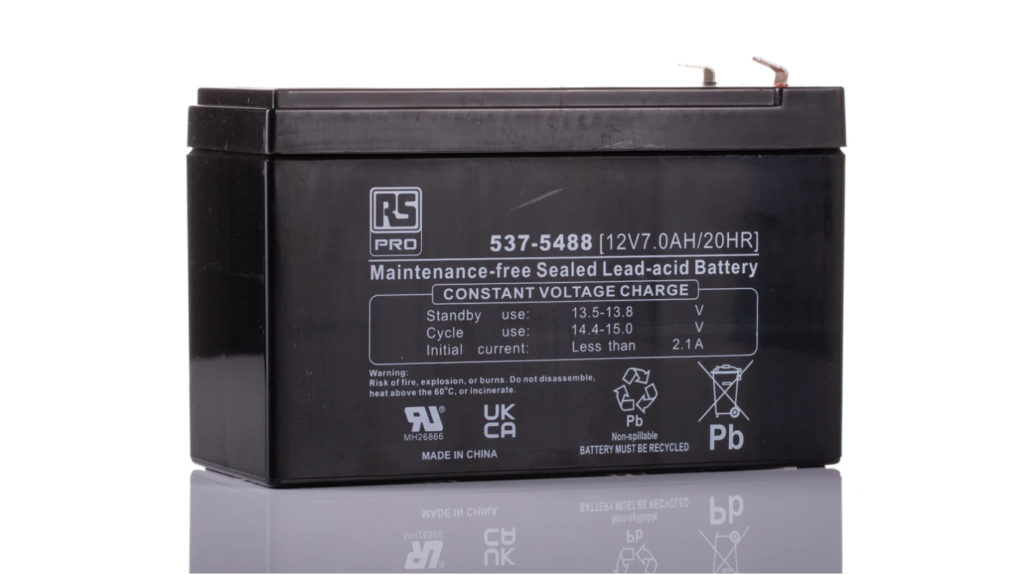
When you drive your car, your battery helps start the engine and powers the electronics.
There are two main types of car batteries: AGM batteries and lead-acid batteries. Both do the same job, but there are key differences between them.
In this article, we will explain AGM vs. Lead-Acid Car Batteries differences simply so you can decide which is best for your car.
What is an AGM Battery?

An AGM battery (Absorbent Glass Mat battery) is a type of lead-acid battery.
It has a special design uses glass mats to soak up the liquid inside the battery.
This makes the AGM battery sealed and maintenance-free, so you don’t need to check or add water as you would with a regular lead-acid battery.
Main Features of AGM Batteries:
- Maintenance-Free: No need to check the water levels or clean the terminals regularly.
- More Power: AGM batteries give more power, making them ideal for cars with many electrical systems.
- Stronger and Safer: They handle bumps and vibrations better, which is why they are often used in off-road vehicles.
What is a Lead-Acid Battery?

A lead-acid battery is the most common type of car battery.
It uses lead plates and liquid acid to generate power. This is the type of battery found in many older and more affordable cars. However, lead-acid batteries require more maintenance than AGM batteries.
Types of Lead-Acid Batteries:
- Flooded Lead-Acid Battery: This is the traditional type of lead-acid battery, which requires you to add water to it from time to time.
- Gel Lead-Acid Battery: This type uses a gel-like substance instead of liquid acid, making it safer and more resistant to leaks.
Comparing AGM vs. Lead-Acid Car Batteries
Here’s a simple comparison to help you understand the AGM vs. lead-acid batteries:
| Feature | AGM Battery | Lead-Acid Battery |
|---|---|---|
| Technology | It uses glass mats to hold the liquid inside | It uses liquid acid and lead plates |
| Maintenance | No maintenance needed | Needs regular maintenance (adding water) |
| Power | Provides more power for advanced cars | Works well for basic cars |
| Lifespan | Lasts 5-7 years | It lasts 3-5 years |
| Cost | About 170$ | About 50$ |
| Durability | Lasts longer and handles bumps better | Can get damaged easily from shaking or leaks |
| Environmental Impact | Safer for the environment, less chance of leaks | Can leak acid if damaged |
Do AGM vs Lead-Acid Batteries Need Maintenance?
AGM Battery Maintenance
- AGM batteries are maintenance-free. You don’t need to check the water levels or clean them often. Just make sure your car’s charging system is working well.
Lead-Acid Battery Maintenance
- Lead-acid batteries require more care. You must:
- Check the water levels and add distilled water when necessary.
- Clean the battery terminals regularly to prevent rust.
- Avoid overcharging the battery, which can reduce its life.
Environmental Impact of AGM vs Lead-Acid Batteries
Both types of batteries can be recycled, but AGM batteries are better for the environment because they are sealed and less likely to leak harmful acid. Lead-acid batteries, on the other hand, can leak acid if damaged, which is bad for the environment.
Which Battery Should You Choose?
Choose an AGM Battery If:
- Your car has many electronic features like GPS, air conditioning, or safety systems.
- You want a battery that lasts longer and requires minimal maintenance.
- You live in an area with extreme temperatures (hot or cold), as AGM batteries handle this better.
Choose a Lead-Acid Battery If:
- You have a basic car without many electronics.
- You don’t mind doing some maintenance like adding water and cleaning terminals.
- You need a cheaper option that works well for simple cars.
Conclusion
In conclusion, whether you choose an AGM battery or a lead-acid battery depends on your car’s needs.
If you have a modern car with many electronics and want something that lasts longer, AGM batteries are a better choice.
If you have a basic car and don’t mind maintenance, a lead-acid battery will work just fine.
FAQs
1. What is the difference between AGM and lead-acid batteries?
AGM vs lead-acid batteries differ mainly in design. AGM batteries use glass mats to hold the liquid, making them maintenance-free and more durable, while lead-acid batteries use liquid acid and require more care.
2. How long does an AGM battery last compared to a lead-acid battery?
AGM batteries last about 5-7 years, while lead-acid batteries last around 3-5 years.
3. Is an AGM battery worth the higher cost?
Yes, although AGM batteries cost more, they last longer and require less maintenance, which can save you money in the long run.
4. What are the maintenance requirements for AGM vs lead-acid batteries?
AGM batteries are maintenance-free, while lead-acid batteries require you to check water levels, clean terminals, and avoid overcharging.
5. Can I replace a lead-acid battery with an AGM battery?
Yes, you can replace a lead-acid battery with an AGM battery, but always check your car’s manual to be sure.